» posted on Sunday, August 25th, 2013 by Linda Lou Burton
A Good Ride
 Linda Burton posting from Albany, New York – Some days are more perfect than others. Today was one of my more perfect days as I drove from Buffalo to Albany. My shoes were still wet from yesterday. But who can complain, when your shoes are soaked by the roaring waters of Niagara Falls. The event is a watery blur in my mind and my pictures don’t help; they mostly show shiny blue ponchos, required clothing on a Maid of the Mist boat ride. I was wearing one myself, but it didn’t prevent the torrent of water that sloshed in over my shoes. Again, and again, and again.
Linda Burton posting from Albany, New York – Some days are more perfect than others. Today was one of my more perfect days as I drove from Buffalo to Albany. My shoes were still wet from yesterday. But who can complain, when your shoes are soaked by the roaring waters of Niagara Falls. The event is a watery blur in my mind and my pictures don’t help; they mostly show shiny blue ponchos, required clothing on a Maid of the Mist boat ride. I was wearing one myself, but it didn’t prevent the torrent of water that sloshed in over my shoes. Again, and again, and again. 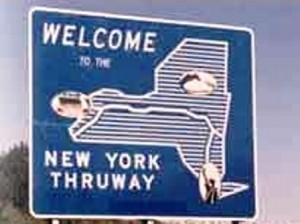 Children shrieked with laughter and mothers gasped as the boat pulled perilously close to American Falls, and then equally close to the Canadian side, and the even bigger Horseshoe Falls. I pulled the front of my poncho down to cover my non-waterproof cameras and blinked the water out of my eyes, unable to hear the narrator, just listening to the roar. And getting wet. Now, that was a good ride; one of those things in life everybody ought to do at least once. I was feeling pretty chipper as I loaded the car this morning in my squishy shoes under blue sky in 70 degree air, perfect. On the outskirts of Buffalo I entered the Toll Plaza
Children shrieked with laughter and mothers gasped as the boat pulled perilously close to American Falls, and then equally close to the Canadian side, and the even bigger Horseshoe Falls. I pulled the front of my poncho down to cover my non-waterproof cameras and blinked the water out of my eyes, unable to hear the narrator, just listening to the roar. And getting wet. Now, that was a good ride; one of those things in life everybody ought to do at least once. I was feeling pretty chipper as I loaded the car this morning in my squishy shoes under blue sky in 70 degree air, perfect. On the outskirts of Buffalo I entered the Toll Plaza 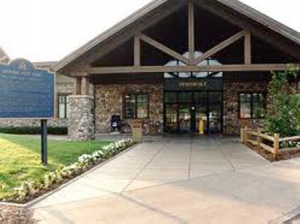 for the I-90 Thruway and got my ticket for another good ride, straight through to Albany. The New York Thruway isn’t fancy and the pavement looks old, but there were no potholes, no construction cones, and few trucks. And best of all, every thirty miles there was a service plaza offering at least three restaurants in a food-court setting, fuel pumps, and information about New York. I stopped at the Pembroke Plaza first, coffee in mind.
for the I-90 Thruway and got my ticket for another good ride, straight through to Albany. The New York Thruway isn’t fancy and the pavement looks old, but there were no potholes, no construction cones, and few trucks. And best of all, every thirty miles there was a service plaza offering at least three restaurants in a food-court setting, fuel pumps, and information about New York. I stopped at the Pembroke Plaza first, coffee in mind.
Pembroke isn’t far from Buffalo; according to the map it is near the Tonawanda Indian Reservation; to the north is the Iroquois National Wildlife Refuge, the Erie Canal, Lake Ontario, and the Thirtymile Point Lighthouse. I stood in line 15 minutes for a cup of Tim Horton’s coffee; apparently I wasn’t the first to feel the call. Coffee and a fresh-out-of-the-oven cheddar cheese bagel in hand and back to the car where the cats were sound asleep; travel on. It wasn’t far to the I-490 exit to Rochester; only 75 miles separates Buffalo, New York’s second most populous city, from Rochester, New York’s third (US Census 2010. New York City 8,175,133; Buffalo 261,310; Rochester 210,565). In 2010 Forbes rated Rochester as the third best place in the country to raise a family; they rated Buffalo tenth best.
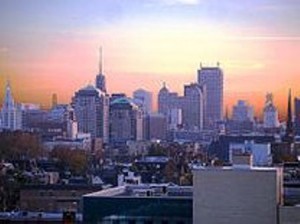 Buffalo, once a highly industrialized city on the shores of Lake Erie, has experienced a severe population decline since it was home to more than half a million people (from the 1920s till the 1950s). Now it focuses on financial services, technology, health care, and education; these sectors continue to grow as the Buffalo Niagara Medical Campus, the University at Buffalo, and The State University of New York have recently undergone major expansions. Some interesting history-of-Buffalo factoids:
Buffalo, once a highly industrialized city on the shores of Lake Erie, has experienced a severe population decline since it was home to more than half a million people (from the 1920s till the 1950s). Now it focuses on financial services, technology, health care, and education; these sectors continue to grow as the Buffalo Niagara Medical Campus, the University at Buffalo, and The State University of New York have recently undergone major expansions. Some interesting history-of-Buffalo factoids:
- 1825. The Erie Canal was completed with Buffalo at the western end.
- 1843. Joseph Dart Jr built the Dart Elevator here; it was the world’s first steam-powered grain elevator and enabled faster unloading of lake freighters.
- 1845. The Michigan Street Baptist Church was built, an important meeting place for the abolitionist movement; Buffalo was a terminus point of the Underground Railroad.
- 1881. Buffalo began using the first electric street lights in the United States.
- 1882. Grover Cleveland was Mayor of Buffalo; he went on to be Governor of New York, and then President of the United States – twice.
- 1901. President William McKinley was assassinated at the Pan-American Exposition in Buffalo; Theodore Roosevelt was sworn in as President in the Wilcox Mansion.
- Buffalo was nicknamed The City of Light due to the plentiful hydroelectric power generated by the Niagara River.
Rochester, on the shores of Lake Ontario, has experienced a population decline since the 1930s; but imaging and optical science businesses are still prevalent; the Institute of Optics of the University of Rochester has imaging programs; think Bausch & Lomb, Kodak, and Xerox. These companies were founded in Rochester; fortunes, and focus, have changed over the years.
- 1853. John Jacob Bausch and Henry Lomb founded Bausch & Lomb and began producing monocles. They went on to produce eyeglasses (1861); microscopes (1876); photographic lenses (1883); spectacle lenses (1889); microtomes (1890); and binoculars and telescopes (1893).
 1884. George Eastman patented the first film in roll form. He went on to perfect the Kodak camera, designed specifically for roll film (1888); the first transparent film, which proved vital to the development of the motion picture industry (1889); and he founded the Eastman Kodak Company, one of the first firms to produce standardized photography equipment (1892).
1884. George Eastman patented the first film in roll form. He went on to perfect the Kodak camera, designed specifically for roll film (1888); the first transparent film, which proved vital to the development of the motion picture industry (1889); and he founded the Eastman Kodak Company, one of the first firms to produce standardized photography equipment (1892).- 1906. The Haloid Photographic Company was founded and originally produced photographic paper and equipment; Charles Chester developed a process known as “xerography” meaning “dry writing” (1938); the named changed to Haloid Xerox and the company began producing the Xerox 914 photocopier (1958); the name changed to Xerox (1961).
I have fond memories of Rochester from a history conference a few years back; a cruise on the Erie Canal, a party at the George Eastman House, a special evening at the Rochester Museum. Rochester has had two nicknames; it was the largest flour-producing city in the country in the early 1800s, hence The Flour City; now it’s called The Flower City due to all the nurseries in the area; it hosts an annual Lilac Festival.
 As the Thruway took me on through the rural countryside, I began to notice swampy areas; the map showed a series of slender, elongated lakes, aka, the Finger Lakes; evidence of glacial activity some two million years ago. I passed close to Cayuga Lake (38 miles long and 453 feet deep) and remembered how Lansing, Michigan got its name; it was named by settlers from Lansing, New York, about 30 miles to the south, near Ithaca. I crossed over I-81 at Syracuse; if I traveled 100 miles north on that road I could enter Canada; if I traveled 800 miles to the south I’d wind up in Knoxville, Tennessee, driving through the
As the Thruway took me on through the rural countryside, I began to notice swampy areas; the map showed a series of slender, elongated lakes, aka, the Finger Lakes; evidence of glacial activity some two million years ago. I passed close to Cayuga Lake (38 miles long and 453 feet deep) and remembered how Lansing, Michigan got its name; it was named by settlers from Lansing, New York, about 30 miles to the south, near Ithaca. I crossed over I-81 at Syracuse; if I traveled 100 miles north on that road I could enter Canada; if I traveled 800 miles to the south I’d wind up in Knoxville, Tennessee, driving through the  Appalachian Mountain range. But I stayed on track for Albany; the road was curving enough to be interesting but not troublesome; I enjoyed the vistas across the valleys that reminded me of my north Alabama roots. Then my Tim Horton’s coffee dictated a second stop. I exited at DeWitt Plaza; the fuel pumps there were Sunoco and unleaded was $3.789. I scrubbed the windshield and talked to the cats; “Move on,” they purred, “let’s go to Albany.”
Appalachian Mountain range. But I stayed on track for Albany; the road was curving enough to be interesting but not troublesome; I enjoyed the vistas across the valleys that reminded me of my north Alabama roots. Then my Tim Horton’s coffee dictated a second stop. I exited at DeWitt Plaza; the fuel pumps there were Sunoco and unleaded was $3.789. I scrubbed the windshield and talked to the cats; “Move on,” they purred, “let’s go to Albany.”
 Along about Utica I crossed both the Erie Canal and the Mohawk River, they followed along roadside for a ways to Herkimer, where the exit south led to Cooperstown and the National Baseball Hall of Fame; Glimmer-Glass State Park and Otsego Lake are near. No more lakes after that; Adirondack Park was to the north; it’s the largest state-level protected area in the lower 48, covering 6.1 million acres. Here’s a factoid: Adirondack Park is greater in size than Yellowstone, Yosemite, Grand Canyon, Glacier, and the Great Smoky Mountain national parks combined! Exits to Schenectady popped up; and finally Albany; the GPS
Along about Utica I crossed both the Erie Canal and the Mohawk River, they followed along roadside for a ways to Herkimer, where the exit south led to Cooperstown and the National Baseball Hall of Fame; Glimmer-Glass State Park and Otsego Lake are near. No more lakes after that; Adirondack Park was to the north; it’s the largest state-level protected area in the lower 48, covering 6.1 million acres. Here’s a factoid: Adirondack Park is greater in size than Yellowstone, Yosemite, Grand Canyon, Glacier, and the Great Smoky Mountain national parks combined! Exits to Schenectady popped up; and finally Albany; the GPS 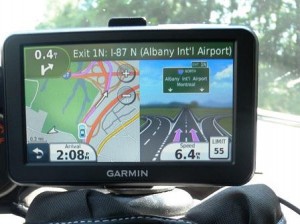 barked instructions and flashed lighted arrows to show me the way; I entered Lane 10 to pay for my 287 miles on the New York Thruway. $12.85, not bad, for a good ride.
barked instructions and flashed lighted arrows to show me the way; I entered Lane 10 to pay for my 287 miles on the New York Thruway. $12.85, not bad, for a good ride.
I have a perfect room here in Albany tonight; top floor, end of the hall, and very quiet. Trees are thick outside the window; a pretty yellow house with a bay window sits on the other side of the fence. The drapes are muted reds and greens, the artwork is Tuscan-inspired, and the carpet must be spotlessly clean, because the cats didn’t even bother sniffing their way around the room after they ate. They simply curled up and went to sleep, content to be home.
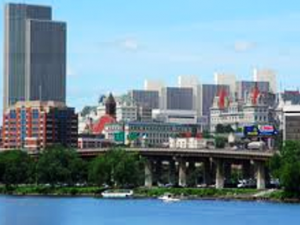 Albany, New York, the 40th stop on the Journey Across America, now 80% complete. What do I know about Albany so far? It is the 32nd most populous capital city with 97,856 residents (US Census 2010); Lansing and Trenton are similar in size. It lies on the banks of the Hudson River, nestled perfectly between the Adirondack Mountains and the Catskills. For the rest, stay tuned.
Albany, New York, the 40th stop on the Journey Across America, now 80% complete. What do I know about Albany so far? It is the 32nd most populous capital city with 97,856 residents (US Census 2010); Lansing and Trenton are similar in size. It lies on the banks of the Hudson River, nestled perfectly between the Adirondack Mountains and the Catskills. For the rest, stay tuned.
